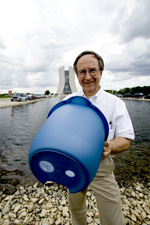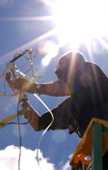Research
Highlights...
|
|
Los Alamos' Manvendra Dubey |
|
 |
| Number 162 |
July 12, 2004 |
First light for SNIFS
The moniker may be inelegant, but the concept is cutting-edge: SNIFS, the Supernova Integral Field Spectrograph built by the international Nearby Supernova Factory (SNfactory), uses lenslets to produce 200 spectra within a six-by-six arc-second region surrounding target supernovae, including their home galaxies and surrounding sky. After months of alignment, calibration (and bad weather) atop Mauna Kea, where SNIFS is mounted on the University of Hawaii's 2.2-meter telescope, the Snfactory, led by DOE's Lawrence Berkeley National Laboratory, declared "first light" late in June. SNIFS will add to the supernova database and improve measurements crucial to choosing among the competing theoretical models of dark energy. [Paul Preuss, 510/486-6249,
paul_preuss@lbl.gov]
|
|
DOE completes 1 million miles of hybrid electric vehicle testing
If the purchase of a new hybrid electric vehicle is in your future, you may be interested in the results of recent testing by DOE. The Advanced Vehicle Testing Activity, managed by DOE's Idaho National Engineering and Environmental Laboratory, recently completed 1 million miles of hybrid electric vehicle fleet testing. The testing includes the miles-per-gallon fuel use, vehicle maintenance and repair data for 18 vehicles, including Honda Civics and Insights, and the Toyota Prius. The cars' fuel efficiencies range from 38 to 46 miles per gallon. Each hybrid vehicle is also dynamometer and track tested.
[Steve Zollinger, 208/526-9590,
gaz@inel.gov]
|
|
Fermilab's SELEX experiment gets long look at surprising new particle
|
SELEX spokesperson Jim Russ of Carnegie Mellon University holds a metaphoric bucket for decays of the newly-observed meson and its unexpected decay pattern. |
Scientists of the SELEX fixed-target experiment at DOE's Fermilab have observed an unexpected new member of a family of subatomic particles called "heavy-light" mesons. This new meson, a combination of a strange quark and a charm antiquark, is the heaviest ever observed in this family. As a rule, the more massive the meson, the shorter its lifetime before decaying into other particles. But this comparatively heavy meson lives three times longer than its lighter relatives. SELEX also saw the new meson decay about six times more often than expected into an eta particle (a rarer but well-studied member of the meson family), rather than into the expected particle, called a K meson.
[Mike Perricone, 630/840-5678,
mikep@fnal.gov]
|
|
PNNL teams on storage for data-intensive computing
DOE's Pacific Northwest National Laboratory has formed a research alliance aimed at enabling a new generation of fast and efficient storage technology for data-intensive computing. Part of a long-term collaboration between PNNL and Silicon Graphics, the alliance includes options for more than 2.5 petabytes of storage over the next two years. PNNL will conduct research into "active storage," a groundbreaking effort to shift computation and transformation of data from client computers to storage devices. The effort holds the promise of dramatic productivity breakthroughs for a broad range of computing disciplines saddled by large data.
[Judy Graybeal, 509/375-4351,
Graybeal@pnl.gov]
|
|
Understanding the weekend effect
Ever notice that weekends are smoggier than weekdays? Probably not, but Robert Harley has. He's one of a growing number of scientists who are studying why smog levels spike on weekends.
"Smog levels always increase in the summer when it's warmer and there is more sunlight," says Harley, with Lawrence Berkeley National Laboratory's Environmental Energy Technologies Division and the University of California at Berkeley's Department of Civil and Environmental Engineering. "But buried in this annual cycle is variability at other time scales, such as the day of the week."
Harley and his colleagues aren't the first scientists to report the weekend effect. It's been noticed in urban areas throughout the world. But they were the first to analyze 20 years of air-monitoring data culled from more than 100 sites throughout California, and determine that the weekend effect has spread inland. They found that this perplexing phenomenon has spread from coastal urban areas such as Los Angeles and San Francisco to Sacramento and the northern San Joaquin Valley.
[Dan Krotz, 510/486-4019,
dakrotz@lbl.gov]
|
|
|
|
Los Alamos scientist follows passion
for understanding the atmosphere
Manvendra Dubey has a passion for understanding the Earth's atmosphere that has taken him around the world. As the Geochemistry team leader in the Earth and Environmental Sciences Division at DOE's Los Alamos National Laboratory and the climate focus leader for the Laboratory's Institute of Geophysics and Planetary Physics, Dubey works closely with Los Alamos staff members, postdocs, and students to understand processes and couplings across the air-plant-soil-water interface by integrating computer modeling with laboratory measurements and field observations.
Dubey began his chemistry studies at the Indian Institute of Technology in his native India. In 1994, Dubey received a Ph.D. in chemical physics from Harvard University where he assisted a group that established the causal link between the chlorofluorocarbons and the Antarctic ozone hole. In 1995, Department of Energy, NASA, and National Science Foundation selected him as an Emerging Senior Scientist in Atmospheric Science.
As an active member of American Geophysical Union, American Chemical Society and the American Association for the Advancement of Science, Dubey nurtures strong interdisciplinary science collaborations in earth system science and as a result has published extensively in a variety of scientific journals and public policy areas. The geochemistry team he leads at Los Alamos has research programs in such diverse earth science areas as water and air quality, carbon management, environmental remediation, containment of radioactive waste, nuclear repositories, global climate change, remote sensing and threat reduction.
At the heart of Dubey's current research is work aimed at resolving what Dubey calls "the aerosol-climate-water puzzle". That research connects the Laboratory's core capabilities in climate modeling and satellite remote sensing with state-of-the-art laboratory experiments. Most recently Dubey has worked with DOE's AmeriFlux Network in establishing a carbon exchange research site at the Valles Caldera National Preserve using sophisticated eddy monitors to study carbon dioxide flow variations and grassland carbon cycle dynamics.
Submitted by DOE's
Los Alamos National Laboratory
|
|





